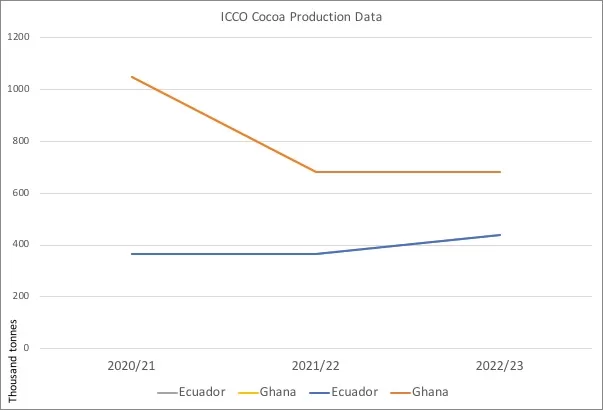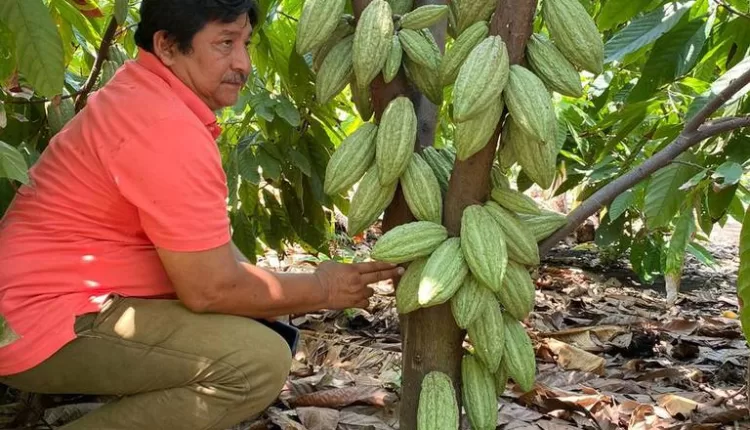In a significant shift within the global cocoa industry, Ecuador is poised to overtake Ghana as the world’s second-largest cocoa producer, according to data from the International Cocoa Organisation (ICCO).
This potential shake-up underscores Ecuador’s steady ascent in cocoa production and its growing influence in the international market.
For decades, Ghana has held its position as one of the top cocoa-producing countries, renowned for its high-quality beans and robust industry.
However, recent trends indicate a notable surge in Ecuador’s cocoa output, driven by strategic investments, improved farming techniques, and favourable growing conditions.
The country’s commitment to sustainability and quality control has further strengthened its position as a key player in the global cocoa trade.
According to ICCO data, Ecuador’s cocoa production has been steadily rising over the past few years, fueled by initiatives to enhance agricultural practices and support local farmers.
The South American country cemented its lead in cocoa production over the past few years by reaching the 365,000-metric-tonne mark in the 2020/21 crop year and repeating the feat in the 2021/2022 season.
In the 2022/23 crop year, Ecuador, the leading cocoa producer nation of the Americas, widened its leadership gap with an output of 440,000 metric tonnes, twice that of the runner-up, Brazil.

Whereas Ecuador recorded a 20.5% growth rate between the last two years, Ghana, on the other hand, saw a 0.44% decline over the period under consideration.
Meanwhile, challenges such as ageing cocoa trees, disease, smuggling, destruction of farmlands for illegal gold mining (galamsey), and climate change-induced extreme weather patterns have posed serious obstacles to the West African country’s cocoa sector.
The development has impacted adversely on Ghana’s local cocoa processing sector, with key factories shutting down because of a lack of cocoa beans.
Despite efforts to address these issues, Ghana has faced setbacks in maintaining its production levels, paving the way for Ecuador’s ascent in the industry rankings.
From a historic high of 1.047 million metric tonnes (MT) in 2020/21 season, Ghana’s production plummeted to 683 thousand metric tonnes in 2021/22 and further down to 680 thousand metric tonnes the season after.
A recent Reuters report quoted experts as projecting Ghana to end the 2023/24 season 40% below target in the region of 490,000 MT or less.
Industry experts suggest that Ecuador’s potential rise to the second-largest cocoa producer spot reflects broader shifts in the cocoa market, with consumers increasingly seeking ethically sourced and environmentally sustainable products.
Ecuador’s emphasis on organic farming practices and fair trade principles has resonated with consumers and positioned its cocoa as a premium offering in the market.
The country’s cocoa sector has since been attracting significant investments, with cocoa and chocolate giant Barry Callebaut outdooring its multi-million-dollar 640-hectare Farm of the Future.
While Ghana remains a vital player in the cocoa industry, experts believe that Ecuador’s trajectory highlights the importance of innovation and adaptation in maintaining competitiveness.
As Ecuador inches closer to claiming the second-largest cocoa producer accolade, the development underscores the dynamic nature of the global cocoa market and the evolving landscape of cocoa-producing nations.
The impending shift in rankings signifies a significant milestone for Ecuador’s cocoa industry and highlights the country’s emergence as a formidable force in the international cocoa trade.
With sustained momentum and continued investment, Ecuador is poised to solidify its position as a leading cocoa producer, reshaping the dynamics of the global cocoa market in the process.
Until Ghana can take dramatic steps to address its domestic challenges hindering its cocoa production sector, the title of the world’s second-largest cocoa producer will remain within reach for Ecuador in the next couple of crop seasons, and deservedly so.
- Illegal Mining Threatening Ghana’s $230M Cocoa Rehabilitation - April 10, 2024
- Ghana Raises Cocoa Farmgate Price by 58.26% to GHC2,070 per bag - April 5, 2024
- New Standard for Measuring Cocoa Household Income Launched - April 5, 2024
